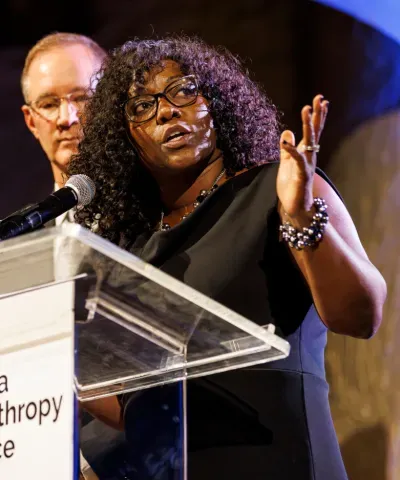Let’s make a “Hoosier Way” - Lessons from the “Columbus Way”
The data shows that the “Columbus Way” is making a positive difference for the small mid-west city. Can the “Columbus Way” become the “Hoosier Way?”

01 June 2025
Visit Columbus, Indiana, and you can’t help but feel a sense of cohesiveness that is often lost in many other communities. There are the physical aspects – the iconic “dancing C’s” community logo, designed by renowned graphic designer Paul Rand; roads and crosswalks painted a vibrant blue, which let you know you are still in the city even on the edge of town; and consistent signage hangs from light posts to guide your way. The connection goes beyond that in the way you’re greeted at local businesses and guided to other Columbus highlights by service staff and excited residents alike.
What locals tout as the “Columbus Way” is a collaborative spirit that centers on excellence. Built on the tradition and culture of early settlers in the area – pragmatism and hard work – and solidified by J. Irwin Miller, early owner and operator of Cummins Engine Company, the “Columbus Way” creates the kind of place where people want to be. The numbers paint the picture. While the state of Indiana and many communities across the state have struggled to maintain population over the last decades, Columbus has seen steady growth. From 2000 to 2020, Indiana experienced a population increase of just under 5 percent. Columbus’s population grew nearly 30 percent.
The educated population also grew. Between 2010 and 2020, the population of Indiana with a bachelor’s degree or higher increased by approximately 6 percent. In the same period, Columbus saw a 12.5 percent rise, not only outpacing the state but also ranking it number one for small and medium metros nationwide. It’s no surprise that, with a more educated population, income is also impacted. As of the most recent Census data, the median household income for Bartholomew County (home of Columbus) is $80,365. The same statistic for the state of Indiana is only $70,051.
The data shows that the “Columbus Way” is making a positive difference for the small mid-west city. Can the “Columbus Way” become the “Hoosier Way?” Four principles from the ‘Columbus Way’ to guide statewide transformation. (quotes by J. Irwin Miller)
“Mastering the ability to work for and with others is the cement of our society.”
Columbus Mayor Mary Ferdon described the “Columbus Way” as “a way of implementing solutions that includes government, business, philanthropy, schools, medical, etc.” She explained that it’s essential to recognize that your decisions affect others and that by involving everyone early, you can better understand the impact of those decisions.
Across the state, we can build and expand cross-sector collaborations to address our biggest challenges. This level of cooperation takes intention and planning. It requires people to hear a variety of perspectives. The effort often pays off with better results that build upon themselves over time.
“We shape our buildings and afterward they shape us.”
In 1942, when the First Christian Church congregation outgrew its sanctuary, congregant J. Irwin Miller commissioned Eliel Saarinen to design the new building. It was the first contemporary building in Columbus and one of the first churches of contemporary architecture in America. The building set the tone for the community, which is now ranked sixth in the nation for architectural innovation and design. People visit Columbus to see its architectural wonders, but for the people who call Columbus home, the buildings are more than works by famous names.
The buildings were designed with care and creativity to meet the challenges they were commissioned to solve. Schools were created with learning in mind and to address community growth. Medical centers are built with beauty and to support patient healing.
With buildings built to last, constructed with beauty and purpose, the norm in the community, residents live with a similar purpose. They take pride and ownership of the places in the community. That pride results in clean neighborhoods and cared-for homes.
To create the “Hoosier Way” modeled from Columbus, we should work to develop and cultivate beautiful, vibrant places that align with the place we desire to be. Buildings, parks, neighborhoods, and homes are the places that shape the people who choose to call Indiana home.
“Nothing is more expensive than mediocrity.”
In Columbus, there is a culture of investing time, energy, and resources up front. This is evident in the community’s commitment (led by Cummins but embraced by most) to hire emerging architects to design public spaces at a much greater expense than a traditional option. The construction of Lillian Schmitt Elementary School, built in 1957, marked the launch of what would become the Cummins Foundation Architecture Program. The Cummins Foundation encouraged the school board to select from a list of approved architects and then covered the cost of the design fees.
Designed by Harry Weese in close collaboration with Brewster Adams, the school was built in brick, glass, and wood, featuring a peaked roofline on each classroom. The design was intended to resemble rows of small houses, aligning the building with the surrounding neighborhood and making the children feel comfortable during their introduction to the school. The school was designed with continued community growth in mind, and it is still an active schoolhouse. The only addition was made in 1991 by architects Andrea Leers and Jane Weinzapfel.
Other schools were built at the same time to rapidly respond to the booming population without investment in quality design. These schools regularly came in over budget and were nearly over capacity at completion. They also haven’t survived the test of time.
The message was clear, let’s stop settling for the lowest bidder. Let’s strive for excellence in our state. Mediocrity carries hidden costs we can no longer afford.
“The process is more important than the product.”
The “Columbus Way” is founded on the principle that there is no single factor that can transform a community. Instead, it is the systems that are built, defined, and refined. As a society, we create systems through relationships, and when these systems no longer meet the needs of the communities they serve, they must be transformed. The only way to transform a system is to transform the relationships within it.
You can’t redesign a system alone. It is a social process. That process, bringing people together to address the challenge, is the real outcome. Columbus uses a framework to address changes in their community that includes documenting the process itself, inviting people to contribute along the way, and committing to an iterative process that continues to look for improvement.
Indiana, too, can strengthen our systems by focusing on strong relationships and developing processes for working together.
As a state, let’s focus on collaboration, invest in vibrant places, strive for excellence rather than the average, and remember that the action of working toward a stronger Indiana is not a one-time thing, but rather an iterative process that will yield significant impact as systems improve.
Let’s make the “Columbus Way” the “Hoosier Way.” Together, we can build an exceptional Indiana.

This article was written by a Mutz Philanthropic Leadership Institute class member. The institute is focused on building Indiana’s talent pipeline of senior professionals and board members within foundations and corporate giving programs.
explore the mutz institute



